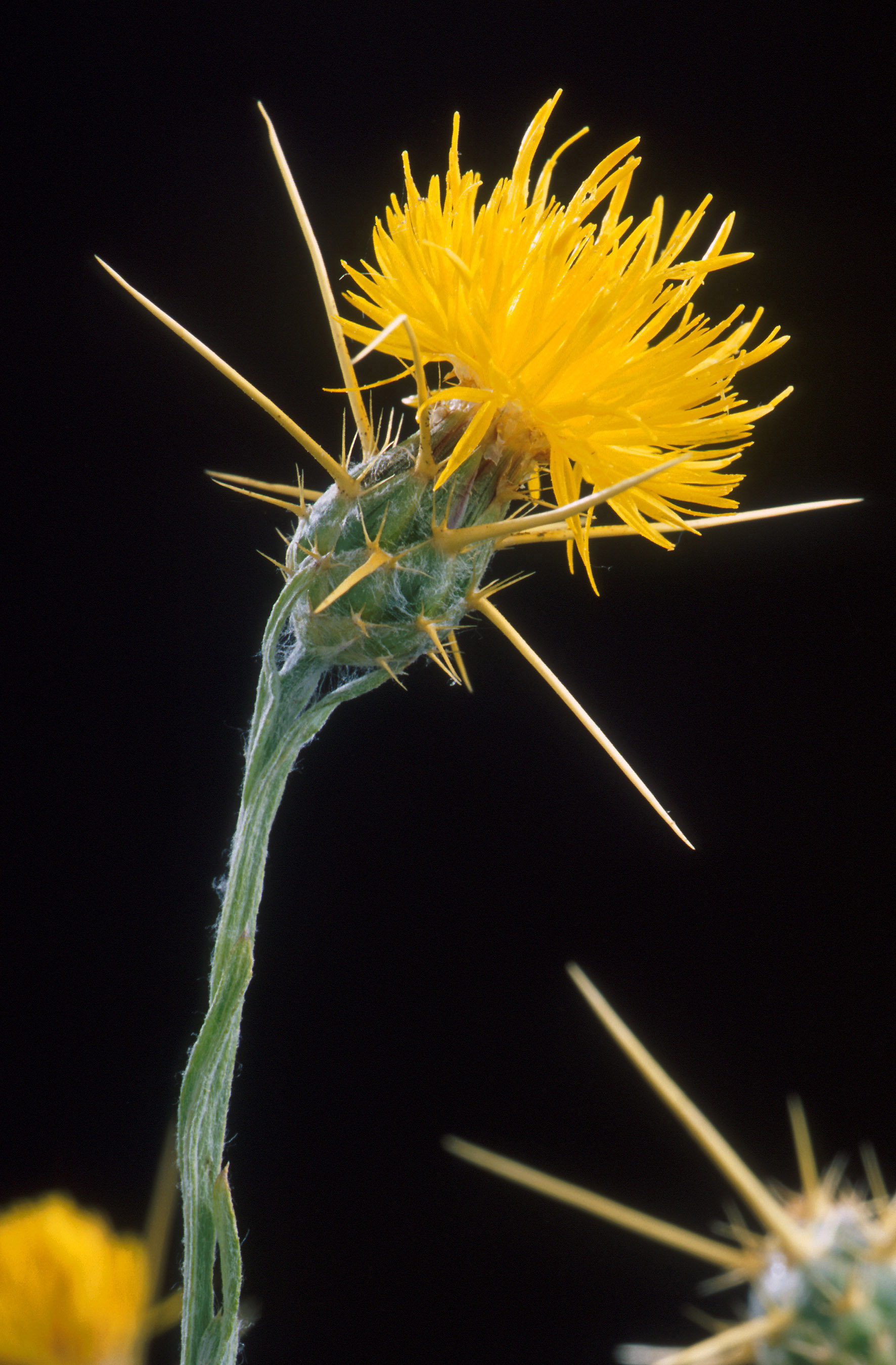- Centaurea solstitialis
Taxobox
name = "Centaurea solstitialis"

image_width = 200px
image_caption = Yellow Starthistle
regnum =Plant ae
divisio = Magnoliophyta
classis = Magnoliopsida
ordo =Asterales
familia =Asteraceae
tribus =Cynareae
genus = "Centaurea "
species = "C. solstitialis"
binomial = "Centaurea solstitialis"
binomial_authority = L.Yellow Starthistle ("Centaurea Solstitialis") is a member of the "
Asteraceae " family, native to the Mediterranean region. The plant, also known as golden starthistle, yellow cockspur, and St. Barnaby’s thistle [cite web|last = DiTomaso|first = J|title = Element Stewarship Asbtract for "Centaurea solstitialis" |publisher =The Nature Conservancy |date = 2001|url = http://tncweeds.ucdavis.edu/esadocs/documnts/centsol.pdf|accessdate = 2007-06-01] is a thorny winter annual in the knapweed genus.It is a grayish-green plant with multiple rigid stems that extend in all directions from the base, forming a bushy-looking cluster that can reach two meters in height and more than that in diameter. It produces bright yellow flowers ringed with long, sharp spines. The plant grows quickly and is very competitive. It bears a
taproot that can reach a meter deep into the soil, allowing it to thrive during dry, hot summers. It is versatile in its growth patterns, and can adapt to drought or low soil moisture content by producing smaller plants with fewer seeds during dry years.Since its introduction to
California in the mid-nineteenth century [http://wric.ucdavis.edu/yst/ Yellow Starthistle Information] from aUniversity of California, Davis (UCD) website] , it has become a large-scale noxious weed throughout the United States, currently dominating over convert|15000000|acre|km2 in California alone [cite web |title = Mount Diablo Review |publisher =Mount Diablo Interpretive Association |date = 2007|url =http://www.mdia.org/PDF%20Files/MD%20Review%20Autumn2007.pdf] .Invasive Species
The plant grows as a normal part of the ecology in
Eurasia , where it is kept in check by an assortment of natural enemies and other plants that have co-evolved with it in its native habitat. (seeco-evolution )Its introduction in
North America probably occurred in California sometime after the start of theCalifornia Gold Rush , as a seed contaminant in Chilean-grownalfalfa seed, also known as Chileanclover ("Trifolium macraei "). After the turn of the century,Spain ,France ,Italy , and perhapsTurkestan were also likely sources of invasion.It was dispersed into agricultural fields in
California , and immediately took hold in the area's Mediterranean-type climate.Human factors such as mowing, domestic animal grazing, and cultivation of wildlands contributed to the success and spread of the plant. It is now a very common sight in pastures, fields, and vacant lots, and along roadsides.By 1970 [ [http://wric.ucdavis.edu/yst/images/none/nc4.jpg1970 distibution of yellow starthistle in the U.S.] , a map from UCD's Yellow Starthistle Information website] , yellow starthistle had reached 23 states. According to the USDA Forest Service, as of 2006 the plant has been reported present in 41 of the 48 contiguous U.S. states, with the only exceptions being
Maine ,Vermont , and five of theDeep South states (Arkansas ,Louisiana ,Mississippi ,Alabama , and Georgia). [http://www.na.fs.fed.us/fhp/invasive_plants/weeds/yellow-starthistle.pdf Yellow Starthistle species profile] from the USDA Forest Service Invasion Species website] The plant is considered aninvasive species in six of the 41 states:California ,Oregon ,Washington ,Idaho ,Utah , andNew Jersey .The yellow starthistle plant has the ability to create monotypic stands in fields that prevent other species from growing there. Whole fields of solid yellow starthistle are not uncommon. Its growth plasticity, competitiveness, preference for the Mediterranean climate, and lack of natural enemies and co-evolved species make it a very successful invader. The plant is a pest in field crops, prevents domestic animals' grazing in rangelands, and acts as a physical barrier to wild animal movement in wildlands. It is toxic to horses. [ [http://www.invasivespeciesinfo.gov/plants/yellowstar.shtml Yellow Starthistle species profile] from the U.S. Department of Agriculture National Invasive Species Information Center]
Biological Control
Yellow starthistle is sometimes resistant to removal methods such as mowing and burning, because of its long root system and the seeds' ability to withstand fire. The plant has been the target of
biological pest control programs with positive results. Six types of seed-feedinginsect have been found to be effective against the plant.
*Three species ofweevil in the beetle subfamily Cleoninae effectively reduce seed production in the yellow starthistle.
** Yellow starthistle bud weevil ("Bangasternus orientalis ") is a fuzzy brown weevil that lays its eggs in the flowers, and when its larvae hatch, they feed on the developing seed.
** Yellow starthistle hairy weevil ("Eustenopus villosus ") is a long-snouted, hairy-looking weevil that lays a single egg inside each flower bud. The larva then consumes the seeds within.
** Yellow starthistle flower weevil ("Larinus curtus ") is a brownish weevil that lays eggs in the flowers as it feeds on the pollen. The larvae then eat the seeds when they hatch.
*Three species of tephritid fruit fly also attack the seedheads of yellow starthistle.
** Yellow starthistle peacock fly and false peacock fly ("Chaetorellia australis " and "C. succinea", respectively) are small nectar-feeding flies that deposit eggs into the seedheads, where their larvae consume the seeds and flower ovaries.
** Banded yellow starthistle gall fly ("Urophora sirunaseva ") produces larvae that pupate within a woodygall within the flower and disrupt seed production.Additionally, a variety of the rust fungus "Puccinia jaceae", first released in July 2003 on a ranch in the
Napa Valley , has shown promise as an agent against yellow starthistle. [ [http://www.ars.usda.gov/is/AR/archive/aug04/fungus0804.htm Fungus Unleashed To Combat Yellow Starthistle] from the U.S. Department of Agriculture website] The rust causes widespread pathology in the leaves of the plant and slow its dispersal.References
External links
* [http://calphotos.berkeley.edu/cgi/img_query?query_src=ucjeps&where-genre=Plant&where-taxon=Centaurea+solstitialis Images from the CalPhotos archive] from a
University of California, Berkeley website
Wikimedia Foundation. 2010.
